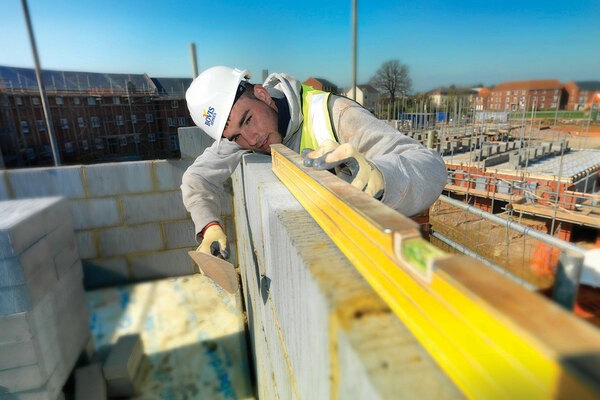You are viewing 1 of your 1 free articles
It’s almost time: what will Brexit mean for the UK social housing sector?
After more than four years of political strife and economic uncertainty, the clock is ticking down the final seconds to the UK’s departure from the EU single market. Inside Housing asks what the changes will mean for the housing sector. Illustration by Eleanor Shakespeare
With a deal still not done and just days left until the big departure many questions remain unanswered about the precise short and long term implications of leaving the European Union for the social housing sector.
But much is known, and has been for some time.
As the hands on the Brexit clock finally reach midnight (or, less poetically, 11pm on December 31), it is worth recapping as much as we can about what it means for the sector.
Materials and labour
Picture: Bovis
The construction sector is heavily reliant on imports from the EU in terms of materials and labour, and the UK’s exit from the single market will have huge ramifications.
While much depends on whether the government secures a deal, the UK’s appetite for European material imports is clear. Around a quarter of all materials manufactured and used in the UK come from overseas, and 60% of those come from Europe. For housing, an even larger percentage of materials are sourced from Europe.
Rebecca Larkin, senior economist at the Construction Products Association (CPA), says: “Timber is the most prominent material that the housing sector relies on. For things like sawn woods and boards we only have a small domestic supply and over 90% of what we use comes from Scandinavia and the Baltics.”
But it is not only the availability of materials that will hit the UK, it is the additional costs on these products, too. Ms Larkin says to expect tariffs on products such as piping, paint and sanitaryware. Construction product tariffs will be up to 10%. Currently there is no tariff on these products.
There will also be indirect costs from the increased level of paperwork, payments on duty and VAT, as well as visa costs for new workers. Arguably, it is the access to these new workers that will hit house builders and developing housing associations the most. Currently, 7% to 8% of construction workers come from the EU, with that rising
to 25% in London.
According to Ms Larkin, these figures are even higher for housebuilding, with just under half of the building workforce in the capital being from Europe. “We know movement of labour is ending so visas will be required,” she explains.
“General labourers and groundworkers are unlikely to meet minimum qualification and salary requirements, meaning house builders of all sizes may struggle to find workers when required,” she adds. The impact of Brexit is already being seen with the number of EU-born workers in the UK falling by 38% in the past two years.
Ms Larkin believes this, along with a number of UK-born construction workers reaching retirement age in the next few years, will see a gap in the workforce, particularly when the economy picks up after the coronavirus pandemic and demand is greater. She does say, though, that the lack of workers could provide an opportunity to train and build
up a workforce to plug the gap.
However, Ms Larkin adds that this is not guaranteed as some employers may see the costs of training workers and the initial slow delivery as more expensive than the new costs around hiring workers from the EU.
By Jack Simpson
Finance
Picture: Getty
This time last year Brexit was arguably the sector’s biggest financial headache. Plenty has changed since then.
Where proactive associations may have been stress-testing for a hard Brexit, they soon became preoccupied by the economic upheaval brought by coronavirus. Those early stress-tests would prove invaluable when the pandemic really took hold, and several housing associations have been renewing these tests regularly ever since.
“We’ve run all the different scenario testing of all the different major impacts and we’ve taken the stress-test for Brexit and overlaid that on our stress-test for a continuation of COVID-19,” explains Mark Spridgeon, director of finance at Abri.
“I do think that the wider pandemic, on top of Brexit, is likely to have an impact on customers and therefore the amount we need to invest in communities,” he adds.
John Bruton, executive director of finance at Stonewater, says his organisation has been reviewing its stress-tests on a quarterly basis as more details come to light about the impact of the pandemic and of a potential Brexit deal.
“We are looking at economic disruption leading to an increase in arrears because of the impact on our customers and we are prepared for some increase in voids,” he says.
Sue Harvey, a partner at Campbell Tickell, warns that 2021 could present “a difficult moment for shared ownership” if the housing market was to slide following the end of the stamp duty holiday in March. She adds: “I think both first tranche and staircasing could be affected by large-scale unemployment levels. There are some [associations] for whom shared ownership is the main source of cross-subsidy to build social homes, so if it dries up it will be a problem.”
With no-deal Brexit looking increasingly likely, some housing associations are looking to insulate themselves from an economic downturn in the new year.
“We have been holding on to a high level of cash reserves and that is in response to the feeling that there may theoretically be some sort of systemic risk to the financial markets as Brexit happens,” says Simon Hatchman, executive director of resources at PA Housing.
He notes that PA has seen a 50% uplift in its liquidity position to prepare for Brexit, meaning the landlord now has three months’ worth of cash requirements, as opposed to its usual two months’ worth.
Housing associations have had a long time to plan and prepare, but the combination of the pandemic and the final departure from the EU means these plans will be tested like few imagined at the start.
by Dominic Brady
In numbers
60%
Percentage of materials that come from Europe
25%
Number of construction workers in London from the EU
Procurement
There is only one change of real significance to housing sector procurement, which kicks in at 11pm on 31 December.
From that moment on, any jobs that breach the procurement threshold (currently £189,330 for services and £4.7m for works) will no longer need to be listed in the Official Journal of the European Union (OJEU). Instead, they will need to be listed on the UK government’s Find a Tender Service (sadly to be known as FTS rather than FATS).
This journal serves precisely the same purpose and many of the current EU procurement rules will continue to be applied nationally via an amendment to existing legislation, which kicks in on Brexit day.
“This amendment will remove all reference to EU standards, processes and procedures, and replace them with UK alternatives,” explains Rebecca Rees, partner and head of public procurement at Trowers & Hamlins. For housing businesses, the only significant change is the switch from OJEU to FTS.
Kris Kelliher, partner at Devonshires, says: “Most of the tender portals clients use will automatically switch over, so it should all happen seamlessly, but we are recommending that they check to make sure.”
Tenders opened before 11pm on 31 December will run under EU rules and existing procurement frameworks will continue to operate undisturbed.
With most housing contracts fulfilled by the domestic market, posting into a national journal is not expected to make a big difference. “Access to the UK housing association market by EU bidders was the exception rather than the rule,” says Ms Rees. “Lots of EU companies had UK companies that they chose to bid through in any event.”
Where things start to get more interesting is a procurement green paper, which was finally published yesterday and will outline a new system for the post-Brexit climate.
“The green paper is going to be a real litmus test as to the extent of Number 10’s rule reform project,” says Ms Rees, speaking ahead of its publication.
The paper outlined proposals to “shape the future of public procurement in this country for many years to come”, including criticism of the current regime for being “too restrictive with too much red tape for buyers and suppliers alike”.
However, these changes remain some way off.
“The green paper will be followed by a white paper and then legislation, so it’s some way off before we see change,” Mr Kelliher adds.
Those who have followed the stilted progress of the Social Housing White Paper will be familiar with this.
by Peter Apps
The general economy
The Bank of England (picture: Getty)
The most direct risk of Brexit to association finances is if the housing market crashes. This would affect market sale and shared ownership developments, cross-subsidies from which subsidise social and affordable housing schemes.
“With the economic brunt being borne in the early months of 2021, that also combines with the end of the stamp duty holiday, which appears to have been supporting affordable homeownership and housing association open market sales just as much as in the private sector, and the end of government support schemes for the labour market,” says CPA’s Ms Larkin.
An economic crisis that drove up unemployment could also leave more tenants in rent arrears, especially when combined with the housing benefit freeze coming next spring. Other risks include a rise in interest rates in response to a falling pound. This would drive up providers’ cost of borrowing and increase defaults by mortgage holders. However, the risk of this seems less likely at this stage, given the Bank of England’s long reluctance to hike rates in a stagnant economy.
More prominent in the minds of the housing sector are staff shortages from falling immigration, which could hit both construction and care work, and the imposition of tariffs and border checks on imported building materials.
Rob Wall, head of policy at the National Housing Federation, adds: “After consulting our members, we found that their major concerns were around the economic certainty and frictionless trade needed to secure finance and materials for new housing development, the loss of funding from European income streams and the shortage in both skilled and unskilled labour.”
Are there potential benefits? In a 2018 report, which it says still holds true, the Chartered Institute of Housing tried to identify potential upsides from Brexit for the housing sector. The UK could, for example, choose to cut
or scrap VAT for home insulation or repair. However, other potential benefits are more speculative and would also contain substantial potential downsides, such as changes to employment law and procurement rules.
by Chaminda Jayanetti
Devolution
Stormont, home of the Northern Ireland Assembly (picture: Getty)
An underdiscussed effect of Brexit on the sector is the impact on the devolution of powers to the Home Nations.
While the UK was part of the single market, Brussels was responsible for setting regulations and standards across the EU. Now that the UK is leaving the EU, Westminster is planning to create a joint market among the four nations of the UK through its controversial Internal Market Bill.
Concerns have been raised around what impact the bill could have on housing in the devolved nations. This is because the bill states that devolved nations will have to accept goods and services from all parts of the UK, even if they have set different standards locally.
It is currently unknown what impact this will have on building regulations and whether this means developers will be able to build new homes in one nation based on the environmental and safety standards of another. Going forward, this could become especially important as the devolved nations set different decarbonisation targets.
Aaron Hill, head of policy and external affairs at Community Housing Cymru, says: “We are concerned that this bill creates a framework that could undermine the high standards we build to, as well as create confusion over who is truly responsible for decisions relating to housing in Wales.”
Stacey Dingwall, senior policy manager at the Scottish Federation of Housing Associations, agrees: “Devolved housing powers in Scotland have seen the delivery of thousands of much-needed affordable and social homes in recent years – homes that are built to higher standards in terms of energy efficiency and safety... Therefore it has been critical for us to highlight the risk the Internal Market Bill could pose to this progress through potential changes to the devolution settlement.”
Both the House of Commons and the House of Lords are currently in the process of debating various amendments to the Internal Market Bill.
The housing sector in both Wales and Scotland will be watching keenly to see what final version is passed.
by Lucie Heath
Sign up for our Week in Housing newsletter
Already have an account? Click here to manage your newsletters
















